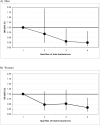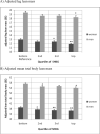Additive benefit of higher testosterone levels and vitamin D plus calcium supplementation in regard to fall risk reduction among older men and women
- PMID: 18351428
- PMCID: PMC2680613
- DOI: 10.1007/s00198-008-0573-7
Additive benefit of higher testosterone levels and vitamin D plus calcium supplementation in regard to fall risk reduction among older men and women
Abstract
Higher physiologic testosterone levels among community dwelling older men and women may protect against falls, and this benefit may be further increased among those taking additional vitamin D plus calcium.
Introduction: The aim of this study is to investigate sex hormone levels and fall risk in older men and women.
Methods: One hundred and ninety-nine men and 246 women age 65+ living at home were followed for 3 years after baseline assessment of sex hormones. Analyses controlled for several covariates, including baseline 25-hydroxyvitamin D, sex hormone binding globulin, and vitamin D plus calcium treatment (vitD+cal).
Results: Compared to the lowest quartile, men and women in the highest quartile of total testosterone had a decreased odds of falling (men: OR = 0.22; 95% CI [0.07,0.72]/ women: OR = 0.34; 95% CI [0.14,0.83]); if those individuals also took vitD+cal, the fall reduction was enhanced (men: OR = 0.16; 95% CI [0.03,0.90] / women: OR = 0.15; 95% CI [0.04,0.57]). Similarly, women in the top quartile of dihydroepiandrosterone sulfate (DHEA-S) had a lower risk of falling (OR = 0.39; 95% CI [0.16,0.93]). Other sex hormones and SHBG did not predict falling in men or women.
Conclusions: Higher testosterone levels in both genders and higher DHEA-S levels in women predicted a more than 60% lower risk of falling. With vitD+cal, the anti-fall benefit of higher physiologic testosterone levels is enhanced from 78% to 84% among men and from 66% to 85% among women.
Figures


References
-
- Amin S, Zhang Y, Felson DT, Sawin CT, Hannan MT, Wilson PW, Kiel DP. Estradiol, testosterone, and the risk for hip fractures in elderly men from the Framingham Study. Am J Med. 2006;119(5):426–33. - PubMed
-
- Fink HA, Ewing SK, Ensrud KE, Barrett-Connor E, Taylor BC, Cauley JA, Orwoll ES. Association of testosterone and estradiol deficiency with osteoporosis and rapid bone loss in older men. J Clin Endocrinol Metab. 2006;91(10):3908–15. Epub 2006 Jul 18. - PubMed
-
- Mellstrom D, Johnell O, Ljunggren O, Eriksson AL, Lorentzon M, Mallmin H, Holmberg A, Redlund-Johnell I, Orwoll E, Ohlsson C. Free testosterone is an independent predictor of BMD and prevalent fractures in elderly men: MrOS Sweden. J Bone Miner Res. 2006;21(4):529–35. Epub 2006 Apr 5. - PubMed
-
- Riggs BL, Khosla S, Melton LJ., 3rd Sex steroids and the construction and conservation of the adult skeleton. Endocr Rev. 2002;23(3):279–302. - PubMed
-
- Pfeilschifter J, Scheidt-Nave C, Leidig-Bruckner G, Woitge HW, Blum WF, Wuster C, Haack D, Ziegler R. Relationship between circulating insulin-like growth factor components and sex hormones in a population-based sample of 50-to 80-year-old men and women. J Clin Endocrinol Metab. 1996;81(7):2534–40. - PubMed
Publication types
MeSH terms
Substances
Grants and funding
LinkOut - more resources
Full Text Sources
Medical
Miscellaneous

